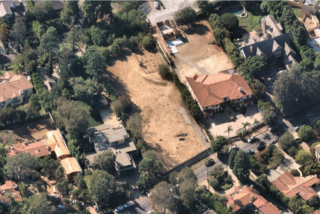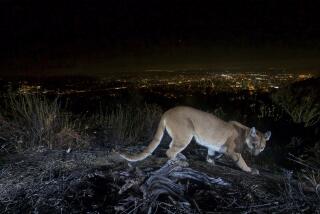Fox in Police Station a Tip-Off to New Habitat : Ecology: As urbanization spreads through Europe, more and more wild animals are settling in the cities. Humans are encouraged to welcome them.
- Share via
LONDON — How the fox got into the Snowhill police station in the heart of this congested metropolis is anyone’s guess. The creature’s discovery in the scene-of-crimes office created an uproar.
After a wild chase, the animal was nabbed and locked up for the night. The next day it was taken to the countryside, where it was presumed to live.
“But what they had was an urban fox. It probably had a very long walk back to its home in the city,” said David Goode, director of the London Ecology Unit, an organization that promotes urban conservation.
That was almost 10 years ago. Since then, as urbanization has spread rapidly throughout Great Britain and the rest of industrialized Europe, more and more wildlife is settling in cities.
English towns house so many foxes that the animal has become the emblem of the country’s urban wildlife movement. London alone is home to an estimated 4,000 foxes. People no longer are surprised to see young foxes romping like squirrels in back yard gardens or schoolyards.
“They’ve become as much a part of the urban scene as pigeons or starlings,” Goode said. “The country’s grown rather fond of them.”
Urbanized creatures are beneficiaries of human fondness in most European countries. Western German cities have inventoried their wildlife. Teachers in the Netherlands are required to be trained in urban ecology. Swiss schools have outdoor classrooms where children study local plants and animals.
Across Europe, formal public gardens are gradually giving way to more natural areas. “We’re all getting away from neat and tidy,” said Meg Game, an urban habitat ecologist with the London Ecology Unit.
Living cheek by jowl with wild animals may not be every Briton’s cup of tea. But the urban English--about 80% of the country’s population--have embraced the idea.
Virtually every English city has an urban wildlife organization promoting the benefits of coexistence. “If you’ve nothing wild in your life, you’re not natural,” one group’s brochure suggests.
Urban wildlife groups organize such events as fox watches, owl nights and butterfly weeks. They publish literature about local wildlife and lobby to protect pocket habitats from human development.
Better-financed organizations own or manage neighborhood centers where schoolchildren learn about ecology and adults commune with nature. London has 52 nature centers.
“They’re for everybody, but especially for people who can’t leave the city to enjoy nature,” Goode said.
In recent years, successive generations of badgers, deer and other beasts have migrated first to older suburbs, then moved deeper into cities as the animals have learned their way around human territory.
The living-with-wildlife theme sets the urban movement apart from other wildlife conservation efforts. Advocates concentrate on the connection between people and animals, rather than on rare species or fragile environments.
“Urbanization has broken that connection,” said Peter Shirley, director of the original Urban Wildlife Trust, in Birmingham, England. “We need to mend it.”
Urban wildlife organizations encourage homeowners to welcome animals onto their property. Many owners plant gardens that provide food for birds or small mammals. Some even equip their chimneys with nesting platforms for large birds, an idea borrowed from Germany.
A small number of truly dedicated people plant their rooftops with sod to create meadow environments for upland birds. Architects are encouraged to think in terms of structures with built-in niches for animal habitats.
“Species that need protection should have it, but most of the wildlife that lives in urban areas is pretty robust,” Shirley said.
A few British urban wildlife advocates are going global. Shirley heads an international effort to make people aware of the wildlife around them.
On International Dawn Chorus Day, usually the second Sunday in May, neighbors gather before dawn to hear the cacophony of birds and other animals as the sky lightens. Groups from Spain, New Zealand and the United States participated this year.
“I love the idea of people around the Earth listening to one continuous dawn chorus,” Shirley said.
City-dwelling animals are gaining advocates in the United States. More people each year visit wildlife refuges in New York, New Orleans and Denver. Florida is establishing an urban wildlife education program. Three years ago voters in Portland, Ore., approved a plan for a metropolitan wildlife refuge system.
“There’s a lot going on here and in Canada,” said Lowell Adams, director of the National Institute for Urban Wildlife in Columbia, Md. “It’s just a matter of time.”
The goal of every urban trust is to establish a small wildlife refuge in city neighborhoods where adults and school groups can relate to resident creatures.
The refuges needn’t be large or beautiful. Tiny wetlands, fragments of hedgerows and even weedy lots have qualified. More than 2,000 potential refuges have been identified in London, including a few abandoned industrial sites.
The city’s Camley Street Natural Park, a 2-acre oasis between a dump and a group of warehouses, was an abandoned coal dump 10 years ago. Urban wildlife activists restored the soil, dug a pond, replanted the landscape and brought in wildlife.
Today, behind the park’s spiraled iron gates, the urban wasteland disappears. Trees and brambles cover the slope down to a small pond. A mother coot plucks small organisms from the surface to feed her ravenous baby.
“A lot of the kids who come here don’t even know ducks can fly,” said Irene Lucas, the park naturalist. She waited on the pond’s boardwalk for her first class of the day, a group of 8-year-olds from a poor neighborhood that is nearly devoid of any life but overcrowded humanity.
Minutes later, Lucas had the children ladling organisms out of the pond with white dip nets. “Hopefully,” she said, “they’ll go away with a more caring attitude.”
More to Read
Sign up for Essential California
The most important California stories and recommendations in your inbox every morning.
You may occasionally receive promotional content from the Los Angeles Times.










